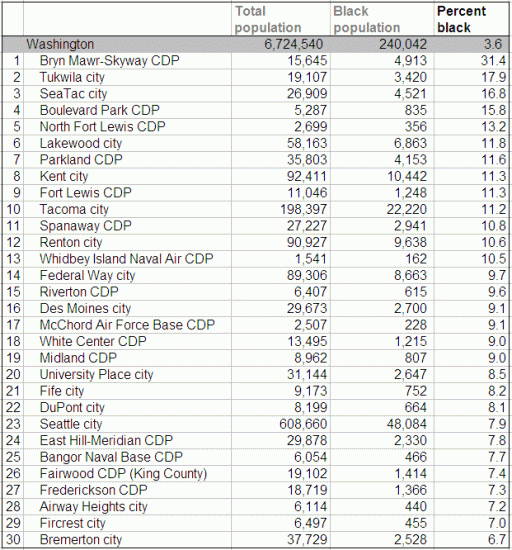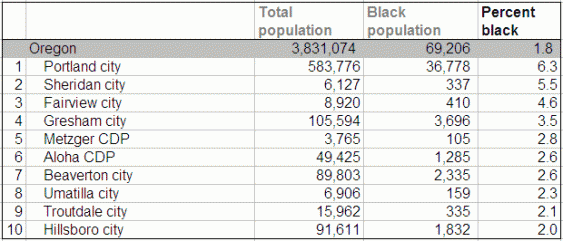I’m a number cruncher, so one way I’m observing Black History Month is by examining census figures for the Northwest’s African-American and African-Canadian populations. (Another way is here.) Although the Northwest does not have a large black population relative to many places in the United States, the region is home to nearly 340,00 residents who self-identify as black, representing 2.1 percent of the population. Among Cascadia’s African-descended people the vast majority, 71 percent, make their homes in western Washington.
It’s often forgotten that Washington’s black communities can trace roots to the years when the area was still contested by Britain and the United States, nearly a decade before the Washington Territory was created. Today, a portion of the relatively large black population in Washington can be explained by the state’s numerous military bases and the strong tradition of military service among African Americans.
The Northwest’s black population is so centered on Puget Sound that Sound-area locales claim all but one of the top 30 spots in the region for shares of people of African descent. In fact, a rank-ordered list for the Northwest turns out to be simply a list of places in Washington, 29 around the Puget Sound and one in eastern Washington. Here it is:
(CDP means “Census Designated Place,” a term that often refers to unincorporated places.)
The data show that although Seattle boasts by far the Northwest’s largest population of African Americans, plenty of other places in western Washington have larger shares. (If some of those place names aren’t familiar, it may be helpful to know that Bryn Mawr-Skyway sits between Renton and Seattle’s Rainier Beach neighborhood; Boulevard Park is located between SeaTac and White Center; Riverton is between Burien and SeaTac; Midland is south of Tacoma; East Hill-Meridian is east of Kent; Fairwood is roughly between Renton and Kent; and Frederickson is southwest of Puyallup.)
Many places in the Northwest with large African American populations are connected to US military installations. North Fort Lewis (5), Fort Lewis (9), Whidbey Island Naval Air Station (13), McChord Air Force Base (17), and Bangor Naval Base (25) all crack the region’s top 30 list. And several other locations are adjacent to military installations, including Parkland (7) and Spanaway (11), both of which abut Joint Base Lewis-McChord. The only place on the Northwest’s top 30 list outside the Puget Sound area is Airway Heights (28) in eastern Washington, which sits between Spokane and Fairchild Air Force Base. It is also home to a state prison, so the high incarceration rates of African-American men may be boosting the numbers there.
Now, let’s take a look at Oregon, Idaho, and British Columbia.
Portland is really the only place outside of the Puget Sound-area that is home to a sizeable population of African Americans. Even Fairview (3), is a small suburb closely connected to northeast Portland.
In Oregon, just two places outside of Portland’s immediate sphere make it onto the top 10 list: Sheridan and Umatilla. Sheridan is southwest of McMinnville at the foot of Oregon’s Coast Range in an area that otherwise has a very small black population. Its standing on the list may be explained by the federal prison located there. In eastern Oregon, Umatilla is next door to the Umatilla Army Depot.
Military bases also play a role in Idaho’s rankings.
Idaho’s top two spots are connected to the Mountain Home Air Force Base, which is about 60 miles southeast of Boise. Garden City is a close-in suburb on Boise’s northwest boundary.
Finally, British Columbia has a small share of people claiming African heritage. (Please note that figures for BC are not directly comparable to the states, and that this list covers metro areas rather than individual cities or places. More details are in the “notes and methods” below.)
I was surprised to find that the province has a smaller share of black residents than Idaho, while famously multicultural Vancouver metro area has an even smaller share than the city of Boise. I was also interested to discover that Courtenay, a relatively rural part of Vancouver Island, is home to Canadian Forces Base Comox, a military site.
Those are the numbers. Now it’s probably about time to complement them with some of the region’s human stories by finally making a trip to Seattle’s Northwest African American Museum.
Notes and methods: For US jurisdictions, I used data from the US Census Bureau’s 2010 demographic profile, “Table GCT-P3: Race and Hispanic or Latino.” Data refer to residents who self-identify as “one race” and “Black or African American.” My tables exclude places with very small total populations. For BC, I used StatCan’s data from the 2006 Canadian Census, the most recent available. All data come from “Population Groups (28) and Sex (3) for the Population of Canada, Provinces, Territories, Census Metropolitan Areas and Census Agglomerations, 2006 Census – 20% Sample Data.” To increase the comparability to the US numbers, I counted only those who identified as a single race. Data in BC are for Census-defined metropolitan areas and census agglomerations.
Regrettably, US Census data for individual cities and places do not allow me to portray multi-racial identification for those who are part African, which I suspect overlooks a sizeable and important part of the Northwest’s population. Indeed, Idaho, Oregon, and Washington all have substantially more people classified as “two or more races” than those who self-identify as “one race” and “black,” but it is not possible to determine how many of these people are part black.
Thanks to Alan Durning, Nicole Bernard, and Rashad Morris, each of whom provided insight for this piece.





Comments are closed.